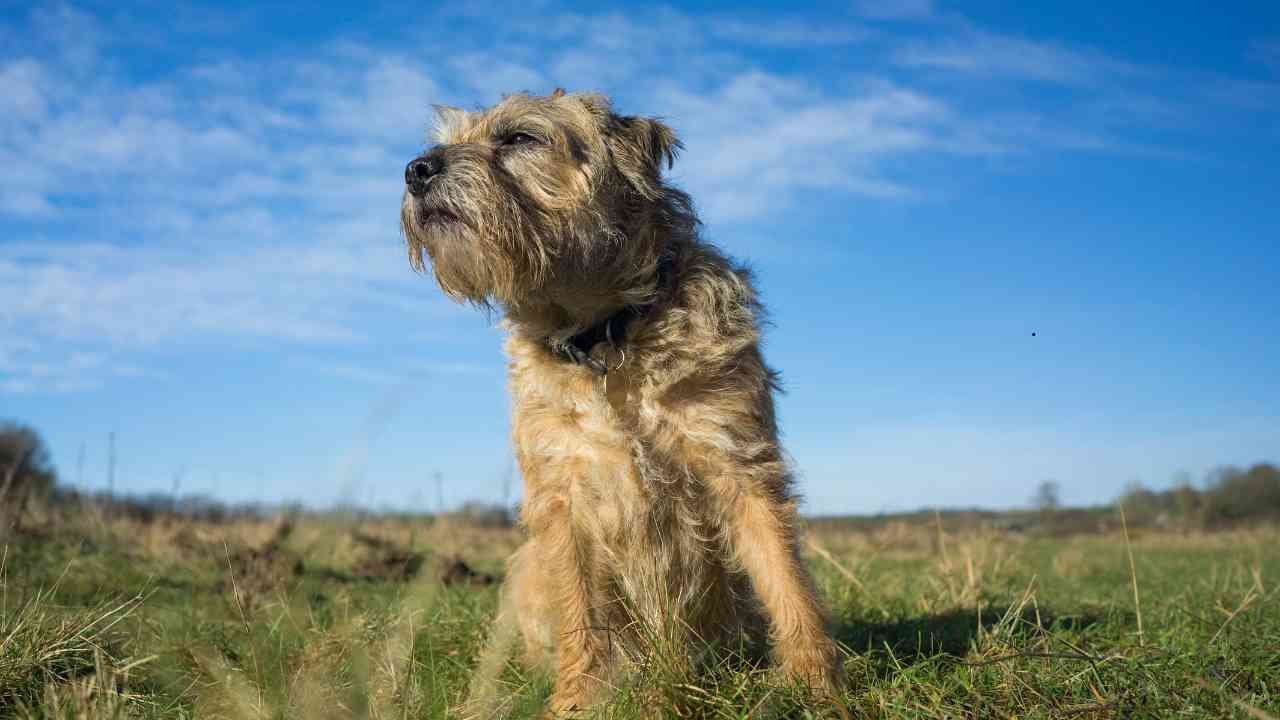Topics Covered in This Blog Post
- Introduction
- Breed Overview of Border Terrier
- History & Origin of Border Terrier
- Border Terrier Physical Appearance
- Temperament & Behavior of Border Terrier
- Training Tips for Border Terrier
- Exercise Needs of Border Terrier
- Diet & Nutrition for Border Terrier
- Health & Lifespan of Border Terrier
- Is Border Terrier Right for You?
- FAQs about Border Terrier
Introduction
The Border Terrier is a small but spirited dog breed known for its affectionate nature and high energy. Originating from the border regions of England and Scotland, this breed was initially developed to help hunters control fox populations. With their distinctive wiry coat and expressive face, Border Terriers have grown in popularity as both loyal family pets and skilled working dogs.
Despite their energetic personality, Border Terriers are known for their friendly temperament and adaptability. They get along well with children and other pets, making them a great choice for active families. Their intelligence and eagerness to please also make training a rewarding experience. If you’re looking for a lively yet loving companion, the Border Terrier may be the perfect fit.
Breed Overview of Border Terrier

Border Terriers are small, sturdy dogs with a rugged appearance that reflects their working heritage. Typically weighing between 11 to 16 pounds and standing about 10 to 11 inches tall at the shoulder, they are compact but tough. Their wiry, weather-resistant coat protects them in harsh conditions, making them ideal for outdoor adventures.
This breed is known for its alert expression and keen intelligence. Border Terriers are agile and quick, with a natural instinct to dig and chase small animals, which ties back to their original role in fox hunting. They are highly adaptable dogs that thrive in various living environments, from rural homes to city apartments, provided they get enough exercise.
Their social nature means they enjoy companionship and generally get along well with other dogs and pets, making them a versatile and lovable addition to many households.
History & Origin of Border Terrier

The Border Terrier originated along the Anglo-Scottish border centuries ago, where it was bred specifically to assist hunters in controlling fox and otter populations. This rugged terrain required a dog that was hardy, agile, and fearless. Border Terriers were prized for their ability to follow scent trails, enter narrow burrows, and flush out prey from dense underbrush.
This breed’s roots trace back to various local terriers mixed with native hunting dogs, creating a versatile and hardworking companion. Over time, Border Terriers transitioned from solely being working dogs to beloved family pets, gaining recognition for their friendly nature and adaptability.
They were officially recognized by The Kennel Club (UK) in 1920 and have since become popular worldwide for both their hunting skills and charming personality.
Border Terrier Physical Appearance
Border Terriers are small yet sturdy dogs with a distinctive look. They stand about 10 to 11 inches tall and weigh between 11 and 16 pounds, making them compact but well-muscled. Their most notable feature is their dense, wiry coat, which is weather-resistant and helps protect them in harsh environments.
Their coat comes in various colors, including red, grizzle and tan, blue and tan, or wheaten. The breed has a characteristic otter-shaped head, with a broad skull, short muzzle, and dark eyes that convey alertness and intelligence. Their ears are small, V-shaped, and lay close to the head.
Border Terriers have a slightly curved tail carried high but not curled over the back, contributing to their balanced, agile appearance. Their overall build reflects their working dog heritage—built for stamina and endurance rather than speed.
Temperament & Behavior of Border Terrier
The Border Terrier is known for its affectionate, energetic, and intelligent temperament. These dogs are lively and curious, always ready to explore their surroundings. They are friendly and social, typically getting along well with children, other dogs, and pets, which makes them great family companions.
Border Terriers are also known for their strong prey drive due to their hunting background, so they may instinctively chase small animals. Early socialization and training are important to help manage this instinct and ensure they behave well around other pets.
Though energetic, Border Terriers are not overly demanding. They enjoy playtime and mental stimulation but also appreciate quiet moments with their owners. Their intelligence makes training relatively easy, especially when approached with consistency and positive reinforcement.
Training Tips for Border Terrier
Training a Border Terrier is usually a rewarding experience thanks to their eager-to-please nature and intelligence. However, their independent streak means they can sometimes be stubborn, so patience and consistency are key.
- Use Positive Reinforcement: Reward-based training with treats, praise, and play encourages good behavior. Harsh corrections may damage their trust and slow progress.
- Start Early: Early socialization helps Border Terriers adapt well to various environments, people, and pets.
- Be Consistent: Regular routines and clear commands help your Border Terrier understand expectations.
- Provide Mental Stimulation: Puzzle toys, obedience training, and games prevent boredom and destructive behavior.
- Manage Prey Drive: Teach a reliable recall command, and supervise them around small animals due to their hunting instincts.
With the right approach, Border Terriers can become well-behaved, happy companions who thrive in active households.
Exercise Needs of Border Terrier
Border Terriers are active and energetic dogs that require regular exercise to stay healthy and happy. Despite their small size, they have a lot of stamina and love outdoor activities. Daily walks combined with playtime, such as fetch or agility games, will keep their bodies and minds engaged.
These dogs enjoy exploring new environments and benefit from activities that challenge their natural instincts, such as scent games or digging in designated areas. Without sufficient exercise, Border Terriers may become bored, which can lead to destructive behaviors like chewing or digging in inappropriate places.
Because of their hunting background, they have a strong prey drive and should be exercised in secure areas to prevent chasing after small animals. Regular exercise not only keeps them physically fit but also helps prevent anxiety and hyperactivity.
Diet & Nutrition for Border Terrier
Feeding a Border Terrier a balanced and nutritious diet is essential to support their active lifestyle. Due to their small size, they do not require large quantities of food but benefit from high-quality meals rich in protein to maintain muscle tone and energy.
Portion control is important to prevent obesity, which can lead to health problems such as joint issues. Feeding them two meals a day rather than one large meal can aid digestion and help maintain consistent energy levels throughout the day.
Border Terriers may enjoy occasional treats, but these should be given in moderation to avoid unnecessary weight gain. Always provide fresh water and consider supplements like omega-3 fatty acids for coat health after consulting your vet.
Choosing a diet formulated for small to medium active breeds will ensure your Border Terrier gets the right balance of nutrients to thrive.
Health & Lifespan of Border Terrier
Border Terriers are generally a healthy and hardy breed with a lifespan ranging from 12 to 15 years. Their robust nature stems from their working dog origins, but like all breeds, they are susceptible to certain health conditions.
Common Health Issues:
- Hip Dysplasia: Though less common, some Border Terriers can develop hip joint problems, so regular vet checkups and maintaining a healthy weight are important.
- Allergies: Skin allergies can affect Border Terriers, often caused by environmental factors or diet. Regular grooming and vet consultations help manage these issues.
- Epilepsy: Some Border Terriers may suffer from epilepsy, which requires veterinary diagnosis and treatment.
- Heart Problems: Rare but possible, so routine health screenings are recommended.
Good care, a balanced diet, and regular exercise will contribute to a long and happy life for your Border Terrier.
Is Border Terrier Right for You?
Border Terriers make wonderful companions for many types of families but may not be suitable for everyone. Here’s who they’re best suited for:
Ideal Owners:
- Active families or individuals who enjoy daily walks and outdoor play
- Those who appreciate a dog with a lively, intelligent personality
- People who can provide consistent training and early socialization
- Homes with children and other pets, thanks to their friendly nature
May Not Suit:
- Individuals looking for a very low-energy or highly obedient dog without much independence
- People unable to commit time to regular exercise and mental stimulation
- Households with small pets like hamsters or rabbits, unless carefully managed
If you want a loyal, energetic, and affectionate dog that thrives on companionship and activity, the Border Terrier could be a perfect match.
FAQs about Border Terrier
Q1: How much exercise does a Border Terrier need?
Border Terriers require about 1 to 2 hours of exercise daily, including walks and playtime to keep them healthy and happy.
Q2: Are Border Terriers good with children?
Yes, they are generally friendly and gentle with children, especially when socialized properly from a young age.
Q3: Do Border Terriers shed a lot?
They have a wiry coat that sheds moderately and benefits from regular brushing to keep it healthy and reduce loose hair.
Q4: How easy is it to train a Border Terrier?
They are intelligent and eager to please but can be a bit stubborn. Consistent, positive reinforcement training works best.
Q5: Can Border Terriers live in apartments?
Yes, as long as they receive enough daily exercise and mental stimulation, they can adapt well to apartment living.
Q6: Are Border Terriers good with other pets?
They usually get along well with other dogs but may have a strong prey drive toward smaller animals, so caution is needed.
Q7: What health problems are common in Border Terriers?
Common issues include hip dysplasia, allergies, epilepsy, and occasionally heart problems.
Q8: What is the lifespan of a Border Terrier?
Border Terriers typically live between 12 to 15 years with proper care.
Explore More Breeds and Conduct Further Research
